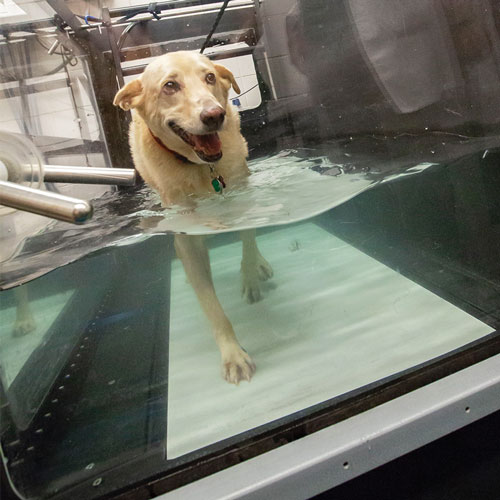The gastrointestinal (GI) tract is the sole conduit for water and other nutrients entering the body. It sustains diverse populations of microorganisms. The liver and pancreas serve important roles in digestion, modulating intestinal microbial growth, and, in the case of the liver, intercepting harmful substances or bacteria originating from the gut.
In patients presenting with signs such as vomiting, diarrhea, or weight loss, the GI tract is readily suspect as a source of the problem. However, the impacts associated with loss of intestinal function—such as malnutrition, dehydration, acid-base abnormalities or electrolyte disturbances, bacterial translocation, and toxemia—may manifest in other parts of the body.
There are a variety of extraintestinal manifestations of GI disease. Sometimes, these signs may appear to indicate disease of non-intestinal body systems when the underlying primary intestinal disease is not obvious.
Hematopoietic Abnormalities
Anemia may arise by a variety of mechanisms in animals with GI, liver, or pancreatic disease. Blood loss through ulcerated GI mucosal lesions or intestinal parasitism may result in anemia that is regenerative. This condition may become non-regenerative microcytic hypochromic, however, with chronicity and development of iron deficiency.
A microcytic hypochromic anemia characteristic of iron deficiency may also result from malabsorption of iron in severe intestinal disease conditions. It may also arise when diffuse gastric mucosal disease (chronic enteropathy, neoplasia) causes loss of gastric acid and proteolytic enzymes responsible for release of iron-containing heme from hemoproteins. Gastric acidity is necessary for maintaining iron in the reduced ferrous form, which has greater bioavailability/absorption from the gut lumen.
Malabsorption of cobalamin (secondary to GI or pancreatic disease) or folate (GI disease) may cause a macrocyticor normocytic-normochromic anemia. Humans with inflammatory bowel disease (IBD), often have other immunological diseases of non-GI tissues. Immune-mediated hemolytic anemia (IMHA) is seen in patients with Crohn’s disease. The association of IMHA and chronic enteropathy has not been identified in small animals.
Patients with liver disease may show anemia due to GI blood loss (predisposition to GI mucosal ulceration), bleeding at other sites (coagulation abnormalities), or decreased red blood cell lifespan (abnormal lipoprotein synthesis, abnormal energy metabolism). Anemia of chronic disease (normocytic, normochromic, non-regenerative) may result from any chronic inflammatory or neoplastic conditions due to suppression of erythropoietin production by inflammatory cytokines.
Leukopenia and neutropenia may occur with enteric infections or systemic infectious diseases involving the gut (parvoviral enteritis, ehrlichiosis, sepsis, feline retroviral infection) and may also result from cobalamin deficiency. Thrombocytopenia may be seen in patients with liver disease, vasculitis secondary to pancreatitis, or sepsis secondary to intestinal mucosal barrier dysfunction or hepatic dysfunction.
Biochemical Abnormalities
Hypoalbuminemia may be present due to liver synthetic failure or protein-losing enteropathy (chronic enteropathy, intestinal lymphangiectasia, diffuse infiltrative, or ulcerative intestinal neoplasia, histoplasmosis). In patients with protein-losing enteropathy, significant protein loss leading to hypoalbuminemia may be present in animals with no diarrhea or other GI signs. Hypoglycemia may develop due to liver synthetic failure, severe malnutrition, or insulinoma.
Electrolyte abnormalities (hypocalcemia, hyponatremia, hypokalemia, hypomagnesemia) may develop in animals with GI or hepatic disease due to reduced intake/absorption, increased loss in vomitus or diarrhea, or other abnormalities in electrolyte metabolism.
Hypoalbuminemia is often associated with a reduced total serum calcium level reflecting a reduction in the inactive, protein-bound calcium fraction but, if the active ionized calcium fraction is normal (which it usually is if hypoalbuminemia is the sole factor responsible for the low total calcium level), the hypocalcemia is asymptomatic and inconsequential. However, ionized hypocalcemia can occur secondary to intestinal disease (due to malabsorption of vitamin D, calcium, magnesium) or acute pancreatitis (due to altered calcium metabolism and binding, calcium precipitation in peripancreatic tissues).
Prerenal azotemia—see Renal/Urinary Signs below.
Neurological Signs
Neurological manifestations of GI disease may occur in a number of conditions. Hepatic encephalopathy (HE), the best known of these, refers to a syndrome of neurologic abnormalities secondary to liver disease. Signs include mental dullness, disorientation, ataxia, hypersalivation (cats), compulsive or aimless wandering, head pressing, blindness, coma and sometimes seizures (more common in cats than dogs). These signs may be waxing/waning and may be precipitated or worsened by a meal (especially one rich in protein), GI hemorrhage, hypokalemia, anesthetics, and sedatives.
The underlying mechanisms of HE are not known, but endogenous toxins (ammonia, mercaptans, gamma-aminobutyric acid, and other false neurotransmitters) normally cleared by the liver accumulate due to reduced hepatic metabolism (due to vascular shunting, such as portosystemic shunt) or obstruction (portal venous thrombosis) or primary hepatocellular failure. This accumulation contributes to the development of neurological signs.
Recent research points to central abnormalities in glutamate handling at the core of HE pathogenesis. Signs correspond roughly to blood ammonia levels and are improved by treatments aimed at reducing blood ammonia levels. Patients with HE are at increased risk for cerebral edema, which may cause acute worsening of neurologic signs, bradycardia, and death if not quickly addressed.
Cobalamin (vitamin B12) deficiency is a common consequence of severe intestinal disease (chronic enteropathy, lymphosarcoma, other chronic enteropathies affecting the ileum), pancreatic disease (exocrine pancreatic insufficiency), or small intestinal bacterial overgrowth (utilization by gut bacteria reducing available luminal cobalamin). Insufficient cobalamin absorption may cause hyperammonemic encephalopathy and seizures and may also cause anemia and organic acidemia, which may secondarily affect nervous system function. Hyperammonemic encephalopathies may also occur as a result of urea cycle enzyme defects, organic acidemias (methylmalonic, propionic, and isovaleric acidemias and maple syrup urine disease), and nutritional deficiencies.
Deficiencies of arginine (an integral component of the urea cycle, which detoxifies ammonia) or carnitine (an essential co-factor in fatty acid metabolism) lead to cytosolic accumulation of metabolites, which inhibit the urea cycle. These deficiencies may develop consequent to malnutrition and may manifest early in the case of anorectic cats.
Pancreatic encephalopathy (PE), a less common and less well-known metabolic encephalopathy, is the most common neurologic complication of severe acute pancreatitis in humans and an important cause of death in this population. Acute pancreatitis results in increased blood-brain barrier permeability (increasing exposure of brain tissue to circulating toxins) and altered brain microcirculation (caused by proinflammatory cytokines) and subsequent vasogenic cerebral edema and brain injury (diffuse encephalopathy: neuronal apoptosis, demyelination, cerebral venous thrombosis, intracerebral hemorrhage).
PE manifests as disorientation/confusion, altered mentation, agitation, aphasia, seizures, and other neuropsychiatric abnormalities. PE has not been described in dogs or cats but occurs reliably in rats with experimentally induced severe acute pancreatitis.
Hypercoagulability secondary to protein-losing enteropathy and associated loss of anticoagulant proteins (antithrombin) may result in ischemic injury. The ischemic injury arises secondary to thrombosis of vessels supplying nervous system tissues, precipitating neurologic signs attributable to the regions served by thrombosed vessels. Pulmonary thromboembolism that causes significant reduction in arterial oxygen content may cause hypoxic encephalopathy.
Hyperviscosity in patients with hypercholesterolemia or hyperlipidemia (pancreatitis) or hyperglobulinemia (Basenji enteropathy) may have similar neurologic consequences (seizures, other central or peripheral neurologic signs) due to vascular compromise and nervous system tissue ischemia.
Hypoglycemia (liver synthetic failure, malnutrition, insulinoma) may cause hypoglycemic neuropathy: brain cells are dependent on blood glucose to support cellular metabolic needs; lack of glucose results in cellular dysfunction, neuronal necrosis, and vascular constriction leading to additional ischemic injury. Clinical signs of hypoglycemia are generally the signs of this consequent nervous system dysfunction: mental dullness, disorientation, weakness, seizures, tremors, blindness, coma.
Thiamine (vitamin B1) deficiency (dogs or cats fed diets that are thiamine-deficient, are preserved with sulfur dioxide, or contain uncooked thiaminase-rich fish/shellfish) causes disruption of carbohydrate metabolism and energy production. This results in signs of cerebral and vestibular dysfunction and may progress to polioencephalomalacia. Clinical signs include generalized weakness, dull mentation, ataxia, stiff/spastic gait, spastic cervical ventroflexion (cats), circling, head tremors, seizures, opisthotonus, stupor/coma and death.
Electrolyte abnormalities may develop in animals with GI or hepatic disease and may precipitate central or peripheral neurologic signs.
Hypocalcemia secondary to intestinal disease (malabsorption of vitamin D, calcium, magnesium) or acute pancreatitis (altered calcium metabolism and binding, calcium precipitation in peripancreatic tissues) causes increased excitability of the central nervous system (CNS) and muscle cell membranes. Hypocalcemia may result in neurologic signs of face-rubbing, muscle rigidity/stiff gait, tremors, tetany, and seizures.
Hypoalbuminemia (liver dysfunction, protein-losing enteropathy) is often associated with a reduced total serum calcium level due to a reduction in the protein-bound (inactive) calcium level. As mentioned above, if the ionized active calcium level is normal, the hypocalcemia is asymptomatic and inconsequential.
Hyponatremia (severe liver or intestinal disease) can cause cerebral edema and diffuse encephalopathy; rapid correction of hyponatremia may cause osmotic demyelination syndrome (CNS signs). Hypokalemia (reduced intake/absorption, increased loss in diarrhea/vomitus) may result in neuromuscular signs of generalized weakness, flaccid cervical ventroflexion (cats), forelimb hypermetria, and wide-based hindlimb stance. Peripheral neuropathy is a common neurological manifestation of IBD in humans. Hyperbilirubinemia can cause brain injury (bilirubin encephalopathy), but its clinical significance is primarily in human neonates.
Renal/Urinary Signs
Prerenal azotemia develops readily in patients with GI, hepatic, and pancreatic disease secondary to reduced fluid intake and increased loss through vomiting and/or diarrhea. This azotemia may be difficult to distinguish from renal azotemia in patients with other factors (hypokalemia, glucocorticoid therapy, liver dysfunction) that influence the patients’ ability to concentrate urine despite normal renal function.
Hypokalemia causes a primary polyuria with compensatory polydipsia due to abnormal urine concentrating ability. Occasionally, dogs with gastric disease show primary polydipsia with secondary polyuria to offload the unnecessary water load. Polyuria/polydipsia occurs in patients with liver dysfunction due to a combination of reduced urea synthesis resulting in reduced renal medullary concentration ability and, perhaps most significantly, alterations in CNS function, including excess adrenocorticotropic hormone (ACTH) release.
Translocation of enteric bacteria and bacterial products to the systemic circulation through diseased intestinal mucosa contributes to progression of chronic kidney disease in humans and contributes to renal injury in patients with cirrhosis.
Hepatorenal syndrome is a condition of acute kidney injury caused by intense renal vasoconstriction causing hypoperfusion of the kidney. Hepatorenal syndrome develops as a consequence of advanced (cirrhotic) liver disease and its associated circulatory changes. These circulatory changes include increased release of endogenous vasodilators, splanchnic and systemic arterial vasodilation, subsequent cardiac insufficiency leading to effective hypovolemia, and renin-angiotensin-aldosterone system (RAAS) activation in the face of increased renal circulatory sensitivity to vasoconstrictors. Clinical signs are those of renal insufficiency superimposed on existing signs of liver failure. Hepatorenal syndrome has been described in dogs but is very uncommon.
Musculoskeletal Signs
Small animal patients with chronic disease of the intestine, pancreas, and/or liver may suffer chronic generalized malnutrition with muscle wasting and weakness. Treatment with glucocorticoids generally exacerbates muscle wasting, especially in larger dogs. As a result of reduced muscle function, increased strain may be transmitted to ligaments, predisposing to rupture. Certain nutritional deficiencies (carnitine, thiamine) and electrolyte disturbances (hypokalemia, hypocalcemia) secondary to intestinal disease may impair muscle function.
Arthropathies are the most common extraintestinal manifestation of IBD in humans, usually involving axial joints (sacroiliitis, ankylosing spondylitis) but sometimes causing peripheral arthritis. Concurrent manifestation of disease in other extra-intestinal sites (skin, mucous membranes, eye) is common in patients with enteropathic arthropathy. Enteropathic arthropathies are not described in small animals. Humans with IBD are at risk for developing osteoporosis and osteopenia resulting from impaired absorption of nutrients important for bone health, effects of inflammatory cytokines on bone metabolism, and impact of glucocorticoid use. Similar complications have not been recognized in small animal patients.
Cutaneous Abnormalities
Food allergy in dogs and cats may manifest as:
- dermatologic disease with non-seasonal pruritis (especially affecting the face and ears) and otitis externa;
- gastrointestinal disease with inappetance, weight loss or poor body condition, and diarrhea
- a combination of dermatologic and GI signs.
Food allergy often first manifests in young animals (dogs under 1 year of age and cats under 2 years of age). The offending dietary allergen has usually been fed for months to years before signs become evident.
Animals with liver disease may show mucosal ulceration due to abnormal protein metabolism and negative protein balance. Humans with IBD often develop dermatologic manifestations (erythema nodosum, pyoderma gangrenosum) and/or oral lesions (aphthous ulcers, granular cheilitis, pyostomatitis), but such associations in small animal patients have not been established.
Vitamin A deficiency (cholestatic liver disease, intestinal malabsorption) can manifest in cutaneous disease with abnormal sebum production, crusting lesions, dry haircoat, and secondary pyodermas.
Superficial necrolytic dermatitis (hepatocutaneous syndrome) occurs in some animals with liver disease. This dermatitis is attributed to increased hepatic catabolism of amino acids, possibly driven by excess glucagon, which leads to deficient levels of circulating amino acids delivered to cutaneous tissues and subsequent pathologic changes in epidermal cells.
Superficial necrolytic dermatitis is more common in dogs than cats. It characteristically manifests first with painful foot lesions (thickened/crusted/fissured foot pads, erythema of interdigital skin), then with crusting and ulceration of mucocutaneous junctions, ear pinnae, and skin of the ventrum and overlying pressure points. Lymph node enlargement and fever may also be present.
Paraneoplastic alopecia is a condition characterized by circumscribed but often extensive areas of alopecia and smooth shiny skin surface with epidermal collarette formation, often involving the ventral abdomen. It is most commonly associated with pancreatic malignancy in cats, although relationship to other malignancies has been described.
Respiratory Signs
Respiratory signs of tachypnea or dyspnea may develop in patients with pulmonary thromboembolism secondary to hypercoagulability in protein-losing enteropathy (PLE) or with acute respiratory distress syndrome (ARDS) secondary to acute pancreatitis, hepatitis, or sepsis resulting from bacterial translocation from a diseased intestine. Tachypnea may also be evident in patients with abdominal pain referable to inflammatory diseases of the GI, liver, or pancreas or conditions causing distention of these organs. Tachypnea is common in patients with significant anemia secondary to GI bleeding or malabsorption of iron, cobalamin, or other factors.
In humans with IBD, extraintestinal manifestations are common but pulmonary involvement is considered relatively rare. Airway (tracheitis, chronic bronchitis, bronchiectasis, bronchiolitis obliterans with organizing pneumonia [BOOP]) or parenchymal (pulmonary interstitial emphysema, interstitial pneumonia, fibrosing alveolitis, granulomatous pulmonary nodules) may develop. However, subclinical pulmonary dysfunction (impaired gas diffusion which worsens with GI disease activity) is common, affecting 40% to 60% of human IBD patients. Similar pulmonary manifestations have not been documented in small animal patients.
Cardiovascular Signs
Pain, anemia, or volume depletion secondary to GI, liver, or pancreatic disease may result in tachycardia. High vagal tone induced by inflammation or distension of abdominal organs, however, may cause bradycardia.
Cardiovascular function may be altered by electrolyte disturbances such as hypocalcemia (tachyarrhythmias, weak pulse), hypokalemia, or hyponatremia (hypovolemia, weak pulse, tachycardia) associated with GI disease. Carnitine deficiency may impair cardiac muscle function. Pulmonary thromboembolism secondary to PLE may result in increased pulmonary artery pressure and subsequent right heart dysfunction.
Impaired intestinal barrier function and alterations in the gut microbiome are implicated as contributing to the pathogenesis of heart failure in humans. Cirrhotic cardiomyopathy is a condition of impaired cardiac contractility with systolic and diastolic dysfunction and conduction abnormalities in humans with advanced (cirrhotic) liver disease; this condition is not documented in small animals.
Ocular Abnormalities
Humans with IBD may develop ocular manifestations including episcleritis, scleritis, uveitis, keratopathy, and night blindness secondary to vitamin A malabsorption, and, less commonly, retinal or corneal disease or lid margin ulcers. Subcapsular cataracts are a common consequence of glucocorticoid therapy (used in managing IBD) in humans. Corresponding ocular abnormalities have not been described in small animals with chronic enteropathy.
Veterinarians should have an awareness that GI disease is a differential for many signs that are not obviously referable to the GI tract, liver, and pancreas. Keeping these possibilities in mind may help to identify the true underlying cause of illness. Ignoring these differentials could significantly delay diagnosis, allowing the disease to progress, or could result in the underlying cause going undetected.
By Dr. Marcella Ridgway, VMD, MS, DACVIM (SAIM)
Dr. Ridgway, clinical professor in the Department of Veterinary Clinical Medicine, heads both the Companion & Zoological Animal Medicine section and the small animal internal medicine service at the Veterinary Teaching Hospital.




